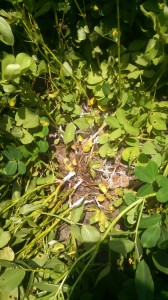Judging by the condition of area peanut fields I’ve seen this week I would wager that everybody has some, either that they know about, or that they don’t know about. Although climatologists were expecting a warmer, drier summer in the Southeast, locally rainfall has been frequent and abundant. Diverse reports have been coming in: one farmer reporting 2.5″ per week for the last month or more, another reporting 7″ last weekend, I have 8″ in my rain gauge at home since the last dump 2 weeks ago (I got tired of dumping it). Nevertheless, the heat and moisture has combined to increase incidence of white mold of peanuts in the last 10 days. I’ve actually struggled to find a field without white mold in the last 7 days. We often say peanuts look the best at 90 days and can only go downhill from there, and most of this crop is approaching 90 days or beyond. Because of the high incidence, and optimum environment for disease, we are using night spraying to keep disease pressure in check where even the best chemical control options broadcast during the day have been ineffective. Unfortunately, we learned the hard way in years past that we need to come back during the day to apply protectants for the prevention of leaf spot, which is usually a serious concern in these wet seasons.
Plant pathologists have begun to rally around the effectiveness of night spraying. Here are some recommendations from the University of Georgia 2015 Peanut Update regarding night spraying of peanuts. 2015 Peanut Update
Research began in 2007 and was continued through 2010 to asses the benefits and potential consequences of spraying fungicides at night for control of soilborne diseases. Because the peanut leaves “fold up” when it is dark, thus opening the interior of the canopy, it is thought that fungicides applied at such time would have better chance of reaching the crown of the plant. For management of soilborne diseases like white mold and Rhizoctonia limb rot, the crown of the plant is targeted for optimum control. Also, it is thought that by spraying fungicides directly into the crown of the plant, the fungicide residues are protected to some degree from sunlight, thus reducing photodegradation and extending the period of efficacy. Below is a summary of findings from the University of Georgia with regards to spraying at night.
a. Control of white mold can be significantly improved by spraying the peanuts at night or in the early morning hours before sunrise. Provided that the fungicide applied at night has systemic activity, i.e. moves within the leaf tissue, there is no significant reduction in leaf spot control, and yields can be significantly improved with night sprays. When sprayed at night, “protectant” fungicides like chlorothalonil and Elast (dodine) will not provide adequate control of leaf spot diseases.
b. Improvement of white mold control is more evident in non-irrigated plots than in irrigated plots when fungicides are applied in darkness, though there is likely to be benefit in both situations.
c. Spraying in the early morning hours before dawn tends to offer slightly better results than in spraying in early evening. It is believed that the dew in the early morning further aids in the relocation of the fungicide.
d. It is believed that applying fungicides at night will either maintain yields and control of white mold and leaf spot diseases or improve white mold control and yields as compared to daytime applications. There is believed to be little risk to the grower by applying appropriate fungicides at night, other than loss of a sound sleep!
e. Note: Only fungicides applied for control of soilborne diseases should be considered for application at night. Fungicides applied only for control of leaf spot diseases and rust should continue to be applied during the day.
f. Final note: growers must ensure that any fungicide or combination of fungicides applied at night has systemic activity against leaf spot diseases.

